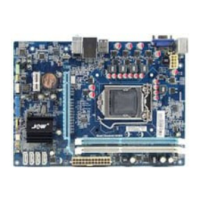
Do you have a question about the J&W JW-H61M-L3 and is the answer not in the manual?
| Socket Type | LGA 1155 |
|---|---|
| Chipset | Intel H61 |
| Form Factor | Micro ATX |
| Memory Slots | 2 |
| Maximum Memory | 16 GB |
| Supported Memory Types | DDR3 |
| Storage Interfaces | 4 x SATA 3Gb/s |
| LAN | 10/100/1000 Mbps |
| PCIe Version | 2.0 |
| LAN Chipset | Realtek RTL8111E |
| Power Connector | 24-pin ATX, 4-pin ATX 12V |
| Audio Channels | 6 |
| Expansion Slots | 1 x PCIe x16, 1 x PCIe x1 |
| USB Ports | 8 x USB 2.0 (4 on back panel, 4 via headers) |
| Audio | Realtek ALC662 |
| Video Outputs | VGA |
Legal statement regarding the manual's content accuracy and intellectual property rights.
Statement on trademarks and product names belonging to their respective registered companies.
Lists included accessories and advises checking for broken or missing parts.
Details technical specifications of the motherboard, including CPU, memory, and connectivity.
Visual diagram showing the physical layout of motherboard components and connectors.
Explains the purpose and connection of rear I/O ports like PS/2, VGA, USB, LAN, and Audio.
Guidelines for selecting a compatible computer chassis for the motherboard.
Instructions on mounting the motherboard securely into a computer chassis using studs or spacers.
Step-by-step guide for safely installing the CPU into the motherboard socket.
Instructions for properly mounting and securing the CPU cooler onto the installed CPU.
Guide on inserting DDRIII memory modules into DIMM slots for single or dual channel operation.
Details on connecting SATA devices and PCI Express cards to the motherboard.
Explains how to use jumpers for configuration, including 2-pin jumper types and their states.
Describes the purpose and procedure for clearing CMOS memory using a jumper to reset BIOS settings.
Details jumper settings for enabling or disabling power-on functionality via the keyboard.
Identifies connectors for powering system cooling fans (CPU and System fans).
Explains connections for case-mounted power/reset switches and LED indicators.
Describes headers for connecting additional USB ports via an optional bracket.
Details pin assignments for the front panel audio header for HD Audio and AC97.
Explains the S/PDIF header for digital audio transfer and its pinout.
Guides on connecting the 24-pin ATX and 4/8-pin +12V power connectors for the motherboard.
Explains what BIOS Setup is and when it is needed for system configuration.
Instructions on how to access the BIOS setup menu using specific function keys.
Details CMOS memory, its role in storing BIOS settings, and battery requirements.
Explains the POST process, its function in testing hardware before OS boot, and POST codes.
Introduces BIOS setup screens, parameters, and warnings about changing settings.
Lists and explains the function of control keys for navigating and operating the BIOS setup utility.
Describes main BIOS menu items and provides an overview of displayed BIOS information.
Details advanced BIOS settings related to Legacy OpROM, ACPI, RTC, CPU, USB, and Power Management.
Covers chipset configurations, including North Bridge parameters, memory information, and SB device controls.
Explains boot configuration options, including timeout, NumLock state, boot order, and ROM messages.
Details password settings for administrator and user access to BIOS setup and system boot.
Covers overclocking settings, including CPU, Memory, Graphics, and Voltage Control.
Explains options for saving changes, discarding changes, restoring defaults, and exiting BIOS setup.
Guides on using the CD to install motherboard drivers, including chipset, VGA, LAN, and audio drivers.
Mentions installation of Kaspersky Internet Security 2011 from the driver CD.
Refers to installing other utilities provided on the driver CD.
Option to browse the contents of the driver and utility CD.